Study Guide for Exam 2 (10/15/2013)
Introduction
In general, the best preparation for the exam is to review your homework assignments
and lecture notes. You should review my
lecture notes posted on this website,
paying special attention to topics highlighted below.
Vocabulary
It is also important to review key terms in the
glossary. You should have a working, practical understanding
of the terms that we use every day in class.
We have also seen a large number of human medical terms used to describe the phenotypes of
human genetic variants. In general, you are not required to be able to define any of these terms.
We have also discussed key experiments and scientists in the development of a comprehensive
theory of genetics. You are not required to know any of the names and dates that we have discussed
in class.
DNA Structure
You should be familiar with the primary structure of nucleic acids, as described
here. You should know which bases
are in DNA and which are in RNA. You should know that A and G are purines and that C, T, and U are pyrimidines.
It is not necessary to know the structure of the bases.
You should understand the Chargaff Rules, as described
here, and know the secondary structure of DNA, as described
here. It is not necessary to understand
how to interpret an X-ray diffraction pattern, but you should understand that DNA is an antiparallel double
helix with the paired bases on the inside and the sugar-phosphate backbone on the outside. It is helpful
to know that it takes 34 angstroms to make one turn of the helix, and that the distance between bases is 3.4 angstroms.
It is important to understand base pairing, especially that GC base pairs have three hydrogen bonds and that AT base pairs have two hydrogen bonds.
DNA Replication
You should understand that DNA replication is semiconservative, as described
here. You should understand the
basic mechanism of DNA replication, as described
here. The key points in
DNA replication are:
- strand elongation always proceeds in the 5' to 3' direction
- this means that there is a continuous and a discontinuous strand
- DNA synthesis requires an RNA primer synthesized by primase
- DNA polymerase has a 3' to 5' exonuclease activity for proofreading
- completion of the synthesis of the discontinuous strand requires DNA ligase, which joins 5'-P and 3'-OH groups in a phosphodiester bond
- completion of the synthesis of the discontinuous strand requires the 5' to 3' exonuclease activity of DNA polymerase to remove the RNA primers
- unwinding the helix for replication requires topoisomerase I (topo I cuts one strand)
- decatenation of replicated DNA requires topoisomerase II (topo II cuts two strands)
You should also understand the Polymerase Chain Reaction (PCR) as described
here. One application of PCR is described
here.
Gene Function
This is discussed
here.
Gene Expression
You should understand the nature of the genetic code. The genetic code is the basis of the
translation of nucleic acid sequence into protein sequence. The genetic code is univerasl (almost).
It is a nonoverlapping triplet code with start and stop signals but no other punctuation. The
genetic code is described
here and
here. It is important to understand that the code is degenerate
(that is, there are synonyms for most amino acids).
You should understand the structure of RNA, and how it differs from DNA (ribose instead of deoxyribose, U instead of T). This is discussed
here. You should understand the basic mechanism of transcription, as discussed
here.
You should understand the major classes of RNA, as discussed
here. The three major types are
mRNA, rRNA, and tRNA. tRNA is discussed
here.
You should understand eukaryotic mRNA processing, as described
here.
You should understand the basic mechanism of translation, as described
here. Remember
that signals to start and stop transcription are different from signals to start and stop translation.
RNA polymerase does not itself recognize transcription start and stop sites; accessory proteins
assist RNA polymerase in doing this, in both prokaryotes and eukaryotes.
Mutation
This is discussed
here.
The Official Word
Here is the exact text of my review points as presented in lecture on Tuesday, October 8.
Vocabulary
1. Terms we use every day in your working vocabulary so that you can read the test questions
2. Medical stuff (kyphoscoliosis, gynecomastia) not required
DNA Structure
Primary structure (sugar-phosphate)
What bases? (not structure)
Chargaff Rules
Secondary Structure (not crystallography)
DNA replication
Basic mechanism (continuous/discontinuous)
Major enzymes and functions
Polymerase Chain Reaction (PCR)
Gene function
Genes encode proteins
Genetics and metabolic pathways
Gene Expression
Nature of genetic code
Structure of RNA, major types
Mechanism of transcription
eukaryotic RNA processing
Gene Expression
Translation in prokaryotes/eukaryotes
Basic mechanism of translation
Nature of genetic code
Questions
We opened for questions. I began by pretending that people had asked three really good questions, listed below.
What do I need to know about genetics and metabolic pathways?
We discussed two topics relating genes
and metabolic pathways. We first discussed Garrod's report of experiments feeding amino acids to
alkaptonurics, as discussed
here. It is really interesting
what you can learn about amino acid metabolism by feeding specific compounds to people with alkaptonuria.
We also discussed the analysis of biochemical pathways in microorganisms using auxotrophs, as discussed
here. Recall that, in general, when we have
a collection of auxotrophs that will grow on various intermediates, auxotrophs that can't grow on
anything but the final product are blocked in the last step in the pathway, while the ones
that can grow on the most intermediates are blocked early in the pathway.
How do I solve that homework problem about the code?
There is a homework problem that
gives partial information on bases in DNA, RNA, and the encoded protein. You are asked to fill
in all the missing information using a codon table and your knowledge of gene expression.
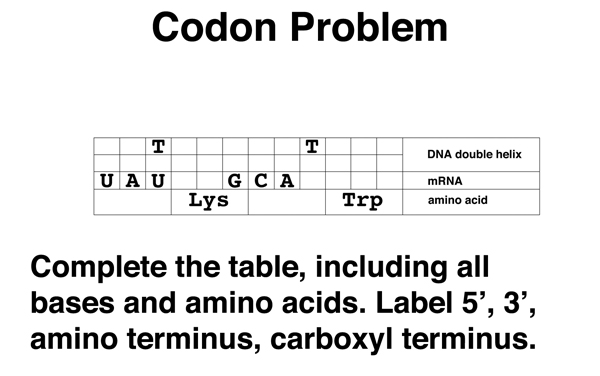 |
It is the usual convention to write RNA and protein from left to right. This problem is
written in that way, but it is important to check before beginning work on the problem.
Notice that if we are reading RNA and protein from left to right, the third base of a lysine
codon is G. AAG is a lysine codon, and there is no lysine codon that begins with G, so we are sure that
this problem is written with the amino terminus of the protein on the left, and the 5' end of the
mRNA on the left. |
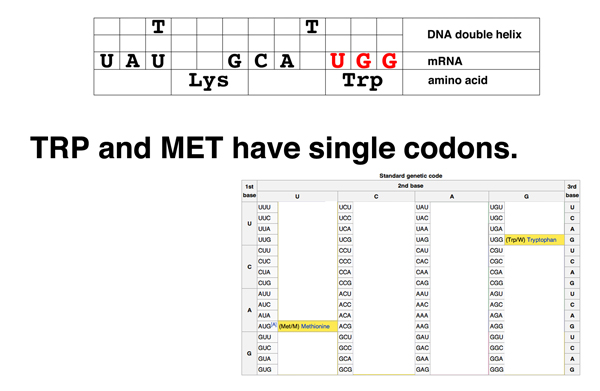 |
We begin by looking for amino acids with unique codons. MET and TRP both have single codons.
We can therefore write in the sequence of the mRNA for the TRP codon as shown. |
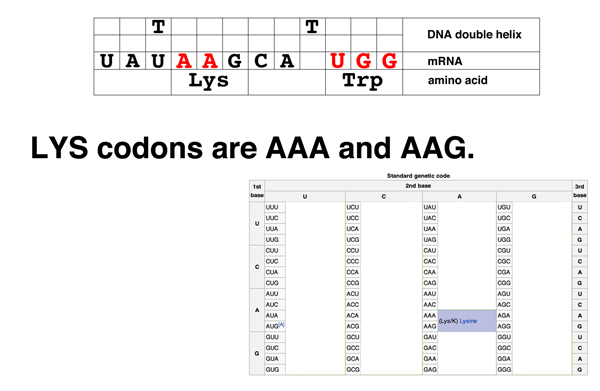 |
Next we see what the codons for LYS are. There are two, AAG and AAA, but we are given the third
base as G. We fill in the mRNA sequence as shown. |
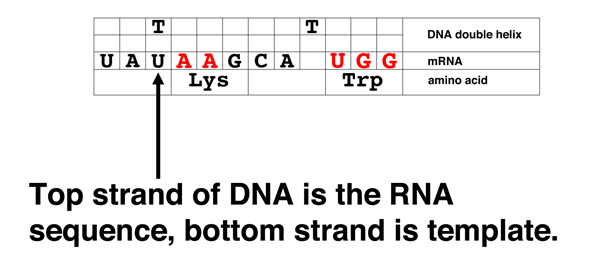 |
There is one position in the mRNA with a U where we are shown the base (T) in one of the DNA strands
at this position. This tells us that the bottom strand of the DNA sequence is the template strand. |
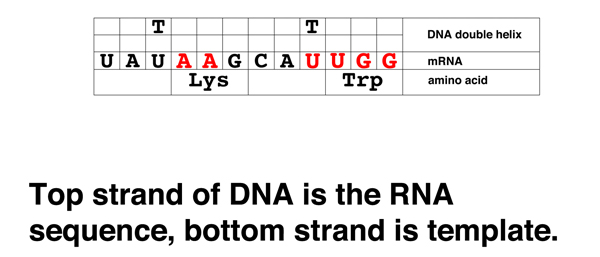 |
We now know that the RNA base at position 9 is U, as shown. |
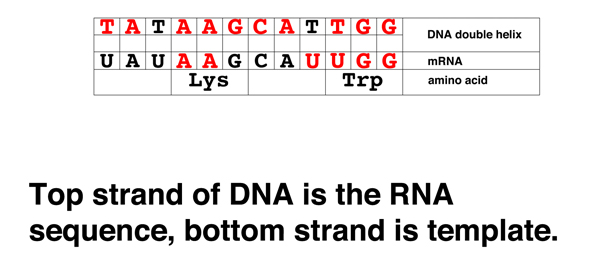 |
Once we have the complete RNA sequence, we can fill in the top DNA strand, substituting T for U. |
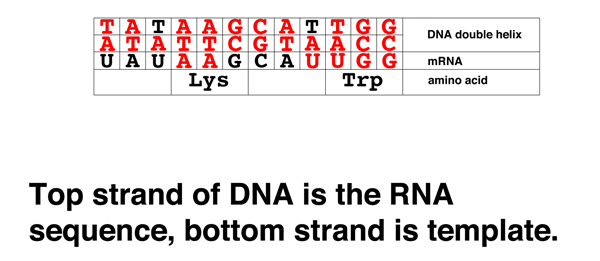 |
We fill in the other DNA strand with the complementary sequence. |
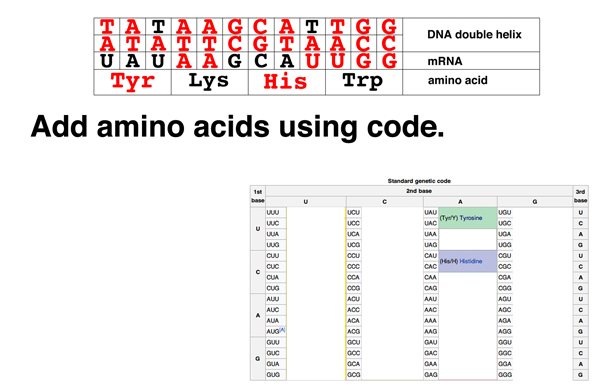 |
We use the codon table to fill in the remaining amino acids. |
 |
Label the ends and we're done! |
What do I need to know from today's lecture?
This part is fairly useful information:
We are often concerned with the number of different codons that can result from single base changes
to an ancestral codon. Taking our initial codon as AAA, we can see that there are three new codons that
result from transitions, six from transversions, or nine possible changes from base substitutions overall, as shown below.
| transition | transversion | base
substitution |
| GAA | CAA | CAA |
| AGA | TAA | GAA |
| AAG | ACA | TAA |
| | ATA | ACA |
| | AAC | AGA |
| | AAT | ATA |
| | | AAC |
| | | AAG |
| | | AAT |
It is also a good idea to understand the different types of mutations resulting from point mutations:
- Silent mutations
- Missense mutations
- Nonsense mutations
- Frameshift mutations
- Splice site mutations
This subject is discussed in the
lecture notes.








